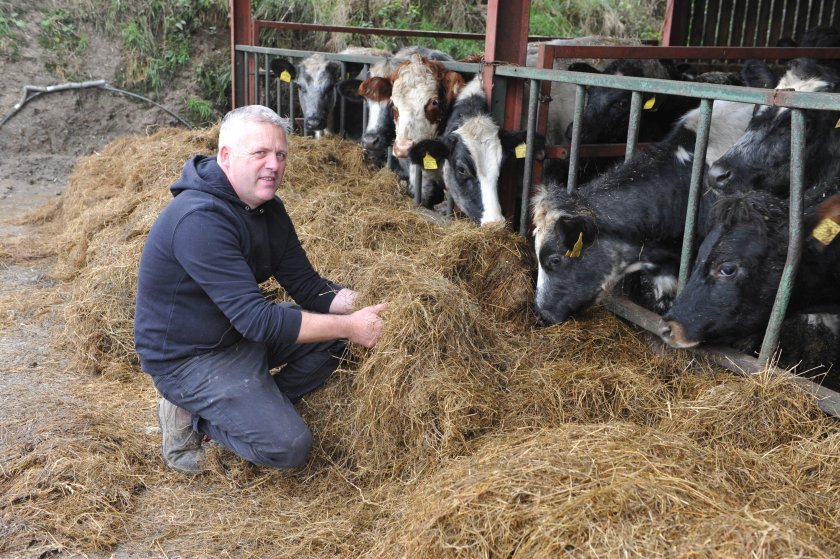
A home mix ration formulated with high quality ingredients and incorporating homegrown forage has provided a cheaper alternative to bought-in concentrates for pregnant ewes and beef cattle on an upland farm.
Richard and Donna Jenkins, who farm in Powys, Wales, had traditionally fed ewes an 18% protein nut for up to six weeks before lambing and housed their cattle on a compound feed too.
But buying feed in compound form was proving expensive at £270 - £340 per tonne at 2021 prices, and that feed wasn’t necessarily best suited to all stock.
The Jenkins’ farm 49-hectare Upper Llifor at Berriew where they run a flock of 250 Lleyn and Lleyn x Texel ewes and 50 British Blue dairy cross cattle.
To reduce cost of production, they sought advice on switching from concentrates to a home-mix ration that made better use of their big bale grass silage and whole crop silage.
With support from Farming Connect development officer, Elin Haf Williams, who facilitated the application, Richard and five other local farmers accessed group funding through the Farming Connect Advisory Service for a ration plan.
This advice was delivered by sheep and beef nutritionist James Hadwin, of Agriplan Cymru.
“This was an extremely valuable service because we were able to have a detailed analysis of the forage we had available on the farm," explains Richard, who also works off-farm as a relief inseminator.
“James calculated the requirements of each cattle group over the winter months and for the ewes pre-lambing, to create suitable ration plans."
The business captured savings of £40-£55 a tonne in the cattle diet. Savings in the sheep system were harder to quantify.
Singles had received 100g of distillers grain two weeks from lambing and twins were fed 500g a day of a mix of barley, soya and distillers three weeks pre-lambing, with triplets rising to 800g a day.
“Traditionally, twins fed eight weeks pre-lambing will eat between 30-40kg of concentrate, which works out at just under £12 per ewe @ £340 per tonne," says James.
“This can be better than halved through monitoring silage quality and ewe condition."
Blood tests are useful to check that the diet is adequate, he recommends. “It also reduces the nerves of changing a system."
Richard and Donna’s ewes lamb indoors from 1 March for four weeks, with housing in the weeks leading up to that – a month for twins and triplets and those that need to gain condition and two or three weeks for the singles.
The aim is for ewes to be at body condition score (BCS) 3.5 – 4 at scanning – the flock scans at an average of 180%.
Adequate nutrition of the ewe during pregnancy is essential for the survival and viability of all lambs conceived.
It can be an expensive period so, with a keen eye on their cost of production, the Jenkins’ looked at an alternative feeding system.
“James formulated the ration and the ewes did really well on it, and it was cheaper than nuts," Richard explains. A mill and mix were purchased to enable on-farm mixing of feed.
Along with grass and whole crop silage, the ration included maize and sugar beet pulp and a high protein and mineral balancer, with the triplets getting wheat distillers and high protein soya too.
As the protein in both the big bale silage and whole crop silage was relatively low, at 12.3 and 9.7 respectively, protein levels in the diet had to be increased according to the class of stock the forage was being fed to.
“At the time, based on local availability, this could be done most cost effectively by using wheat distillers for cattle and a combination of distillers and hi pro soya for the sheep," explains James.
"Distillers is a high protein and energy feed and balances the forage well." With this system, it is crucial to ensure adequate feed space per ewe.
“The feeding system dictates the feed space requirements but in this instance, ewes ideally need 15cm per head to ensure maximum intakes and feed needs to be presented well and fresh to ensure good intakes," James advises.
In optimum circumstances dry matter intakes can be raised to three per cent of body weight and above, reducing the need for as much supplementation and feed cost per ewe, he adds.
Cost savings were captured in the beef system during the winter housing period too.
Growing cattle up to 300kg received 12kg big bale silage, 1kg wheat distillers, 0.5kg maize/SBP mix and minerals per head per day.
For in-calf heifers, which have small requirement for frame growth, the daily ration per head included 28kg whole crop silage, 0.5kg wheat distillers and minerals.
Growing cattle should be regularly weighed to check the response to diets, James advises.
At Upper Llifor, lambs are finished on grass and mostly sold deadweight to Kepak at Merthyr Tydfil.
For their beef system, Richard and Donna buy bucket-reared heifer calves and grow these to breed from and calve at three years to sell as cows with calves at foot, either directly from the farm or through a livestock market.
Reflecting on the support accessed through Farming Connect, Richard says it enabled the business to trial a different feeding system that ultimately saved money.
“Every farm business has to watch its costs, whatever you spend ultimately comes off the bottom line."
